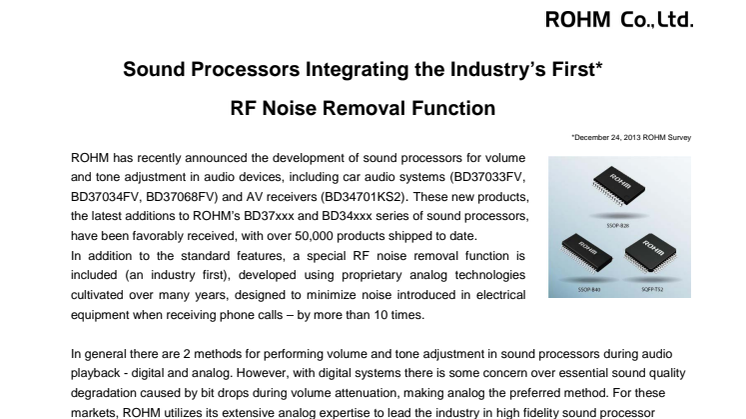News -
Sound Processors Integrating the Industry’s First* RF Noise Removal Function
ROHM
has recently announced the development of sound processors for volume and tone
adjustment in audio devices, including car audio systems (BD37033FV, BD37034FV,
BD37068FV) and AV receivers (BD34701KS2). These new
products, the latest additions to ROHM’s BD37xxx and BD34xxx series of sound
processors, have been favorably received, with over 50,000 products shipped to
date.
In addition to the standard features, a special RF noise removal function is included (an industry first), developed using proprietary analog technologies cultivated over many years, designed to minimize noise introduced in electrical equipment when receiving phone calls – by more than 10 times.
In general there are 2 methods for performing volume and tone adjustment in sound processors during audio playback - digital and analog. However, with digital systems there is some concern over essential sound quality degradation caused by bit drops during volume attenuation, making analog the preferred method. For these markets, ROHM utilizes its extensive analog expertise to lead the industry in high fidelity sound processor development.
In recent years, with the increased proliferation of high resolution sound sources such internet delivery and SACDs (Super Audio CDs) that exceed the standard of CDs, along with noise reduction in HEVs and EVs, comes a greater demand for higher sound quality in audio devices and systems. In addition, widespread usage of mobile phones makes it important to minimize RF noise when receiving incoming calls.
These
products inherit the essential characteristics of existing systems, such as low
noise and low distortion for high sound quality, as well as advanced switching
in order to eliminate popping noise during volume and tone adjustment. New
features include the industry’s first RF noise removal function for audio
equipment that cuts noise generated by incoming phone calls, along with an audio
leakage prevention function that activates when power supplies connected to an
external amp are turned OFF.
ROHM takes advantage of expertise obtained through repeated, long-term evaluation using in-house listening rooms and EMC testing in ROHM’s anechoic chamber, along with proprietary analog technology in regions that cannot be duplicated through simulation, to meet market needs for superior audio fidelity.
Pricing: 500 yen (Samples)
Availability: Now (OEM Quantities)Key Features
1.RF noise induced by
incoming mobile phone calls cut by more than 10x
The industry’s first RF noise removal function cuts unpleasant noise introduced in audio equipment when receiving wireless phone calls – without the need for additional components or external countermeasures.
2.Sound leakage prevented when using external power amp (BD37034FV)
The internal sound leakage prevention circuit reduces sound leakage generated when power supplies attached to an external power amp are turned OFF to only 1/30th the original level.
3.Low-frequency noise reduction improves sound quality
4.Popping noise eliminated during volume/tone adjustment
ROHM’s advanced switching operation minimizes popping noises generated when adjusting the volume and/or tone for smooth, natural audio transition.
Terminology
・High Resolution Audio Source, SACD (Super Audio CD)
Music on standard CDs are played back at a sampling frequency of 44.1kHz and 16bit quantization. In contrast, high resolution sound sources typically feature a sampling rate of over 48kHz and more than 24bit quantization. For this reason, the amount of data will be much higher for a high-res audio source than a normal music CD.
SACDs are considered to be the next-generation CD standard, with a sampling frequency of 2.8224MHz and 1bit quantization.
・RF (Radio Frequency) Noise
Generally refers to high-frequency noise generated by communication devices. For example, RF signals emitted from mobile phones utilizing various communication methods such as TDMA and CDMA can induce noise in nearby audio circuits.
・Total Harmonic Distortion (THD)
A value representing the degree of signal (sound) distortion. The smaller the value the lower the distortion.
・Popping Noise
Refers to the sound generated during volume/tone adjustment (during sound processor switching).
Topics
- Telecom
Categories
- industry’s first

